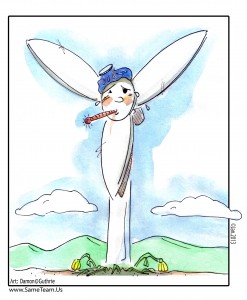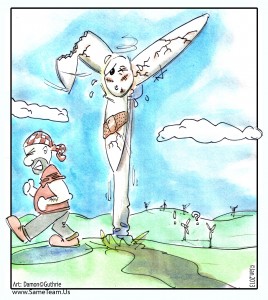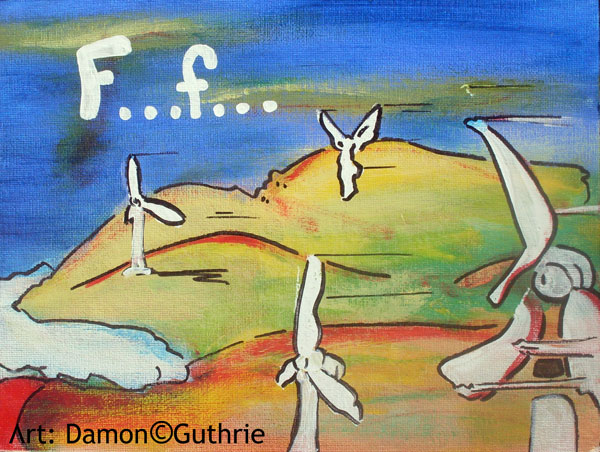Last year, I published a series critical of modern wind farms. They dealt with a number of pretty dirty land deals in southern Mexico related to new wind farms. Although they were on the cover of a major national newspaper, they didn’t get the attention I thought they deserved (as with most of my stories, oddly enough). It was a sad story in an overlooked corner of the continent.
But one sliver of that attention especially bothered me – those who used it as an argument that wind power is just as bad as coal and gas. That’s why a few weeks ago at a placebo conference (yes, it’s a real conference – not just a bunch of fake scientists and a fake audience) my head snapped around at a lecture on the health effect of wind power. Apparently, there is an idea out there that wind turbines can make you sick. The idea goes that people exposed to very low sound waves, called “infrasound” (say 40 decibels at five hertz for the nerds out there) might experience sleep disturbance, headaches, dizziness, tinnitus, ear pressure or pain, nausea, concentration problems, irritability, anger, panic episodes, fatigue, loss of motivation.
But it just starts there. Since this list was published under dubious pedigree, the list has grown, including asthma, Asperger’s, anemia, allergies, angina – to a whopping 223 symptom. For one couple, the turbines even altered the space/time continuum and aged them five years. So what is all this? Are wind turbines actually bad for your health? Well, one group in New Zealand, led by Keith Petrie thought they knew the answer. Perhaps, they reasoned, it was the media itself that was causing the “pandemic.” They turned to the rather slim but growing literature on the nocebo – placebo’s grumpy little brother.
The group then designed one of those lovely little experiments that make nocebo research so fun. They took 54 volunteers and split them up. Half would watch a six-minute video about the dangers of infrasound and the others would watch one about how safe they are. Then both would be exposed to it.
Except half of them just got silence. What happened was that the people who were warned about nasty effects experienced them, whether exposed or not. In fact, it was almost impossible to separate who had heard the infrasound and who had gotten silence. What I found most interesting was even the people who were told there was no danger and experience the fake sound reported some symptoms. If you read that list above, can you honestly say you have none of those symptoms right now? Hell, “Tinnitus, Fatigue, Concentration Problems, and Loss of Motivation” is going to be the title of my autobiography.
Of course the next step was to see if they could reverse the symptoms. So with another group, they changed the neutral description to a positive one (infrasound makes all your problems go away!). Sure enough, overwhelmingly the bad-news group felt symptoms while the good-news group felt better (though, again, a small sliver of good-news people still got worse, which just shows that people like to complain to people in lab coats).
Wind power has a long way to go before it is a major player in global energy and in the meantime, it seems to be learning how to steal land from highly marginalized communities. But it’s not making you sick.
All images created and included with permission by the very talented Damon Guthrie.

“it was almost impossible to separate who had heard the infrasound and who had gotten silence.” This tidbit exposes the ridiculous nature of the so-called experiment. The LFN causing problems for mammals is “inaudible”. Perhaps this important work should be left up to Audiologists, Acousticians, Radiologists and other scientists who know the difference between inaudible and audible noise and how the “sound” presents itself to the human body.
It’s an interesting point, Mary. I summed the paper up faster than I would have liked (there was also a group that got the infrasound). It was 150 people or so – I think that a sample size of 1,000 would have been better, but I think it was a good first go. I’ll post the paper as soon as it’s out and you can judge for yourself.
A similar study was done on a wind farm site in Wisconsin, the Shirley Windfarm. While the study concluded no significant impact, it helped to create the belief that wind farms cause illness, Wind Turbine Syndrome, which has also proven to be a condition that only exists in people who are not able to be within a windfarm. It seems their condition may be a manifestation of stress, but not because of the wind turbines, because of their jealousy for neighbors getting an income by leasing their land for a turbine. Check out the docket at WI Public Service Commission 2535-CE-100. The PSC just last week voted to NOT approve a permit for the wind farm and they cited noise concerns of the community. A prefect example of how fake science can be used by politicians to vote against a much needed wind farm. I live in the community (not within the wind farm) that this project would be built in. Plenty of noisy tractors and huge farm equipment…..
I understand the idea of conducting these studies to denote the effects of wind turbines (newer? technology). However, what we don’t see in these discussions is the comparison of health effects of coal power plants. Burning coal has many, many more detrimental health issues for humans, as well as other animals and insects than wind power. Here we aren’t even speaking about the land and waste issues! As such, why not use the lowest common denominator (of health problems) now until another type of energy production is found which has even less issue?